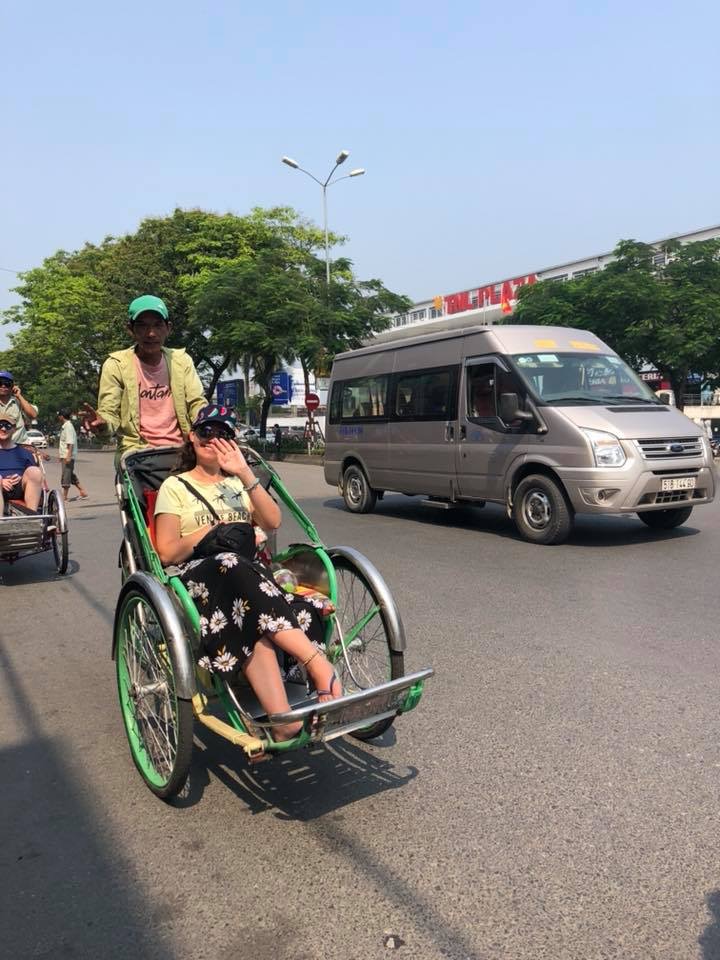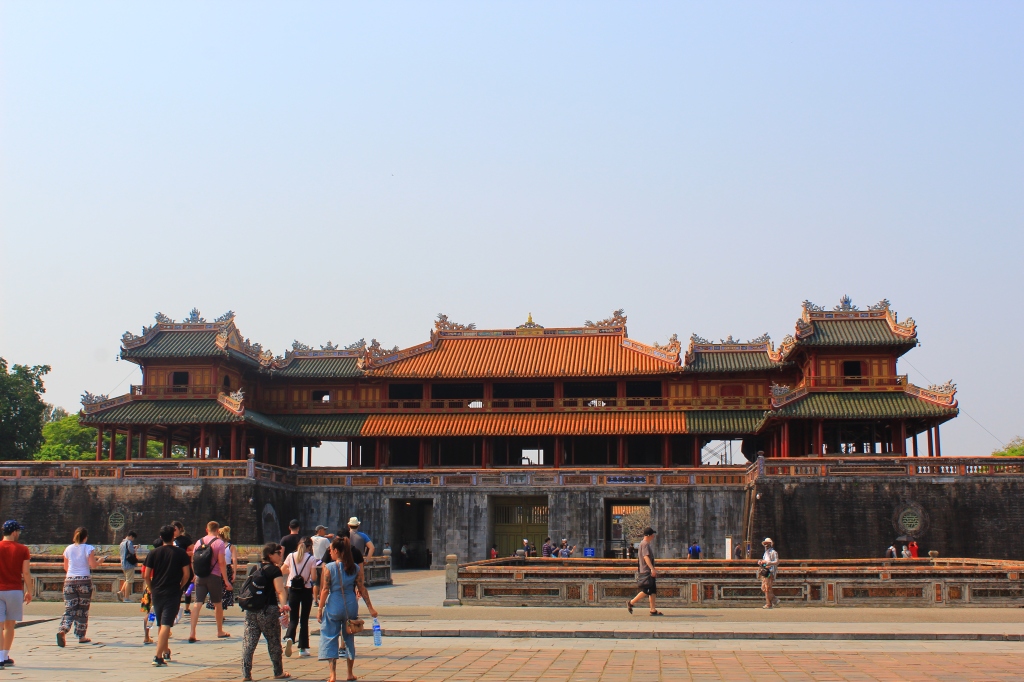It was the twenty-third day of my ‘Big Indochina Adventure’ with Contiki, and today we were sad to be leaving the absolutely stunning city of Hội An. It felt like we had just arrived, but equally we had seen so much of its beauty already. I knew that I would love to return here one day, but for now it was on to our next destination, and I realised that I shouldn’t be too disappointed as we were heading to a city famous for its food and architecture. We hopped on board our tour bus and took a three-and-a-half-hour coastal drive to Huế.
The views on our way to Huế were breathtaking, and our journey has been described as one of the most beautiful coastal drives in the world. Aptly, our tour leader, Lee, played us an episode of Top Gear, where the three presenters travelled around Vietnam on motorbikes, and they also ventured on the same gorgeous drive from Hội An to Huế.

This stretch of road overlooking the East Sea and the Annamite Mountain Range is known as the Hải Vân Pass, which translates to mean “ocean cloud pass”. Its name refers to the mist that rises from the sea which can reduce visibility for drivers, so we trundled along the coast slowly and carefully. The twisting roads along the 21-kilometre mountain pass are challenging for drivers and passengers alike, and when not admiring the view, I tried to sleep so as to avoid bringing up my breakfast as we snaked and swerved along!

Eventually, we arrived at the former imperial town of Huế, had a quick bite to eat and got into our temple-appropriate clothing, before heading out on a very interesting form of transport…



These cyclos had people at the back who pedalled us along, and this method of transport was traditionally used by the rich in Vietnam before cars. The man controlling my cyclo told me that he loved his job of driving tourists around his home, and he pointed out the hidden charms of Huế as we travelled. He was proud to show off the city’s architecture and he enjoyed the exercise too! I felt like a lady of leisure and it was funny seeing our group riding alongside each other on these interesting bikes. It was a fantastic, lazy way to get around the city.


We cycled past Dong Ba Market, the largest market in Huế, and admired the sights that passed us, appreciating the cool breeze. Before long, we arrived at the Imperial Citadel for our City Highlights Tour. We took a quick group photo outside, with views of the Flag Tower looming above. I was excited to enter the Citadel and find out more from our local tour guide, Quang.

Click here to view my 360° tour of Huế’s Imperial Citadel
Known as the capital of Vietnamese Buddhism, Huế was actually the capital of the country from 1802 to 1945, during the reign of the Nguyen Dynasty. The Imperial Citadel is a forty-five-acre walled fortress which was built in 1804. Though some natural disasters, and most predominantly, the Vietnamese/American War, destroyed parts of the Citadel, a lot of the fascinating architecture remains, and Quang explained its rich history to us.
The site of the Citadel was chosen by spiritual scientists of the Nguyen Dynasty because it had good omens in the natural landscapes. It is situated on the bank of the Sông Hương, nicknamed the Perfume River, because the orchids which fall into the water give it a lovely, sweet smell. Mountains also surround the Citadel, and these were thought to protect the city because, according to the experts, they resembled snakes and lions.
The first emperor of the Nguyen Dynasty, Gia Long, was known for his ferocity and he managed to unite the country into one single empire by attacking any other rulers who dared to face him. His dynasty was the last in Vietnam and it was in place for 143 years.
The Imperial Citadel was recognised as a UNESCO World Heritage Site in 1993 and though only 20 of its 148 buildings are still intact, there are restoration efforts in place to preserve what remains for years to come. Alongside the flag tower and other highlights of the Citadel, pictured below is Cần Chánh Palace, where Emperor Gia Long worked and held feasts.















After admiring the Imperial Citadel, we hopped back on our cylos and headed to Thiên Mụ Pagoda. Situated four kilometres southwest of the citadel, the seven-storey pagoda is an iconic unofficial symbol of Huế and its beauty makes it the perfect subject for folk rhymes and songs written about the city.
Sitting atop Hà Khê Hill, each of the pagoda’s seven storeys is dedicated to a manushi-buddha (a Buddha that appeared in human form). Thiên Mụ Pagoda was originally founded in 1601, but it has been destroyed and rebuilt several times along the way. The 21-metre octagonal tower that exists today was constructed in 1844, and since the 1960s it has been used as a prime location for political demonstrations.
The pagoda is surrounded by beautiful gardens, and we climbed up some steep steps to go inside. This was worth it though, as we saw some Buddhist monks praying and observed the serenity of the temple. As we entered the pagoda, we were told to be silent and soak in the calm atmosphere of the prayer happening in such an exquisite setting.




After an afternoon of intricately decorated pavilions, lotus flower ponds, colourful artwork, sightseeing and learning lots about Huế (including Quang’s interesting fact that bats are a symbol of happiness in Vietnam), it was time to head back to our hotel and get ready for our evening activity.
Tonight we were heading on a street food tour to get a taste of authentic Vietnam in the most delicious way possible! We split into two groups and jumped in separate minibuses, probably so we didn’t overwhelm the food places with one large gathering. My half of the tour were led by a really friendly guide called Van. A lot of the places we visited looked rather unassuming, but then supplied us with incredible delicacies.
Our first stop was to a vegetarian restaurant, where we had fig salad, lotus salad with cucumber, tofu, carrot and banana leaf and spring rolls with carrots, mushrooms, tofu and green beans.
The second eatery gave us bún bò, a noodle soup that consists of meat and is similar to the phở dishes of northern Vietnam, which we would be soon be sampling in Hanoi, but made with different noodles.
Thirdly, we went to a restaurant that specialised in rice flour pancakes with meat and beansprouts, and where we could make our own spring rolls using coleslaw, mango, fig, cucumber and meat skewers.
By restaurant four, it was a struggle to keep eating, but I knew I wanted to at least try each dish. This place served one of the most interesting of the cuisines; fish noodle soup, condensed milk yoghurt and quail eggs.
Our fifth stop served up a traditional dish from Huế called bánh bèo. This is a popular street food, and it translates into English as “water fern cakes”. Bánh bèo is made using tapioca flour and rice flour with minced meat and shrimp (I am not a big seafood fan though, so I had mine without the shrimp).
The last restaurant we visited served up deep fried meat dishes and mushrooms as well as deep fried banana. By this point those members of the group who were lucky enough to have buttoned trousers were undoing them to allow for all the food we had just consumed to sit more comfortably!
Rubbing our stomachs happily and reclining in our chairs feeling very satisfied from all the wonderful food, we thought we were finished for the night, but then the restaurant owners brought out the final food item. Bizarrely, it was a fertilised duck egg, and we were told that this is known as an aphrodisiac in Vietnam! A few of us were brave enough to try some and it actually tasted quite similar to other eggs, despite looking a little less appetising.








After an excellent day exploring Huế, it felt like we were leaving as quickly as we had arrived. The following morning we departed our hotel and drove to the airport, to board a flight to Hanoi, Vietnam’s capital city.
Watch this space to find out about my time in Hanoi, the city of lakes, with some of the busiest streets I’ve experienced, a vibrant nightlife, and a multicultural community.
Hue must be such an interesting city! The food tour sounded delicious. I think I’d like to try the fertilized egg.
LikeLiked by 1 person
Thank you so much for reading! I really hope you can go in the future and enjoy the delicious food 🥰
LikeLike
What a great blog on Huế, Vietnam. We have been contemplating a trip to Vietnam and this is certainly helping to push us in that direction
LikeLiked by 1 person
Thank you so much for reading, Steve! I’m so glad you enjoyed it and really hope you can visit beautiful Vietnam in the future ☺️
LikeLike
I’ve spent some time in HCMC and Saigon, but never made it to the middle of the country. I know I’m definitely missing out!!
One thing I love about SE Asia is how colorful its pagodas and buildings are. 🙂 Oh. and the food! I’d love love love to go on a street food tour!
LikeLiked by 1 person
You would love it, Lannie! Really hope you can visit ☺️ it’s so beautiful and the food is delicious!
LikeLike
And thank you so much for reading!!
LikeLike
Enjoyed this Becca. You certainly had an action packed trip. Hue looks a beautiful place to visit with some lovely choices of restaurants and food
LikeLiked by 1 person
Thank you so much, Liz! It was very action packed, that’s for sure! Really glad you enjoyed reading and I definitely recommend stunning Huế ❤️
LikeLike